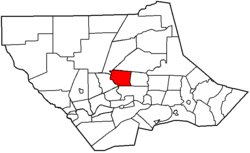Hepburn Township, Lycoming County, Pennsylvania
| Hepburn Township, Pennsylvania |
|
|---|---|
| Township | |

Blooming Grove Dunkard Church, built ca. 1805
|
|
 Map of Lycoming County, Pennsylvania highlighting Hepburn Township |
|
 Map of Lycoming County, Pennsylvania |
|
| Coordinates: 41°18′53″N 77°2′34″W / 41.31472°N 77.04278°WCoordinates: 41°18′53″N 77°2′34″W / 41.31472°N 77.04278°W | |
| Country | United States |
| State | Pennsylvania |
| County | Lycoming |
| Settled | 1784 |
| Formed | 1804 |
| Government | |
| • Type | Board of Supervisors |
| • Chairman | Joseph Hamm |
| • Vice-chairman | Robert Fesemyer Jr. |
| • Supervisor | Oscar Schon |
| Area | |
| • Total | 16.6 sq mi (43.1 km2) |
| • Land | 16.6 sq mi (43.1 km2) |
| • Water | 0.0 sq mi (0.0 km2) |
| Elevation | 906 ft (276 m) |
| Population (2000) | |
| • Total | 2,836 |
| • Density | 170.4/sq mi (65.8/km2) |
| Time zone | Eastern Time Zone (North America) (UTC-5) |
| • Summer (DST) | EDT (UTC-4) |
| ZIP code | 17728 |
| Area code(s) | 570 |
| FIPS code | 42-33944 |
| GNIS feature ID | 1216751 |
| Website | Hepburn Township |
Hepburn Township is a township in Lycoming County, Pennsylvania, United States. The population was 2,836 at the 2000 census. It is part of the Williamsport, Pennsylvania Metropolitan Statistical Area.
Hepburn Township was formed from part of Loyalsock Township in 1804. It is named for William Hepburn who was a former state senator and one of the founding fathers of Lycoming County and Williamsport which is the largest city in Lycoming County. Hepburn Township was originally much larger in size than it is today. Lewis, Gamble, Eldred Township, and Cascade Townships all are formed from territory that was at least formerly part of Hepburn Township.
An Indian village known as Eeltown played a prominent role in the early history of what is now Hepburn Township. This village located on Lycoming Creek near the present village of Hepburnville was an important village on the Sheshequin Path. The Indian name for Eeltown is unknown, but the whites named it for the plentiful eels that could be found in the waters of Lycoming Creek.
Hepburn Township was settled by three distinct groups of European migrants. The western section along Lycoming Creek was largely settled by the Scots-Irish, the middle section known as Blooming Grove was settled by a German religious group, the Dunkard Brethren, and the eastern section of the township was settled by the Quakers. John and Gottlieb Heim were among the first Dunkards to settle in Hepburn Township. The Heims were imprisoned in Württemberg, Germany as conscientious objectors. A condition of their release from prison was that they would agree to leave Germany forever. Upon their release John and Gottleig moved to the United States. They settled in Lycoming County and founded a religious community and village known as Blooming Grove. Soon other Dunkards from Germany were to join the Heim brothers. They built log cabins and quickly cleared the land for farming. In addition to clearing the land the Dunkards were also free to worship God in a manner that they saw fit. Their faith was banned in Germany. The newly arrived settlers worked hard to clear the land and credited their success on their faith in God. The new farms prospered almost immediately, they "bloomed like flowers". Hence the name Blooming Grove.
...
Wikipedia
